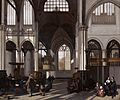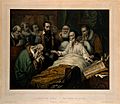Reformed churches facts for kids
The Reformed churches are a group of Christian churches that are part of the Protestant movement. They follow beliefs similar to those taught by John Calvin. These churches started in Switzerland during the Protestant Reformation in the 1500s. Important leaders like Huldrych Zwingli and John Calvin helped them grow. Soon, Reformed churches spread across Western Europe.
Each country where the Reformed movement began had its own way of organizing its churches. Many of these churches grew into large groups found all over the world. Sometimes, these groups split into smaller ones.
Contents
History of Reformed Churches
The Reformed churches began in Europe during the 1500s. This was a time of big changes in Christianity called the Protestant Reformation. Leaders like John Calvin and Huldrych Zwingli taught new ideas about faith and church practices. Their teachings led to the formation of the first Reformed churches.
What Reformed Churches Believe
Reformed churches express their beliefs in special documents called "confessions" or "catechisms." These texts explain what the church teaches about God, faith, and how Christians should live. Different Reformed churches use different confessions, often based on their history.
Some important confessions still used today include:
- The Heidelberg Catechism (written in 1563)
- The Belgic Confession (written in 1566)
- The Canons of Dordrecht (written in 1619)
- The Westminster Confession of Faith (written in 1646)
These three (Heidelberg, Belgic, Canons of Dordrecht) are often called the "Three Forms of Unity" because many Reformed churches worldwide use them together.
How Reformed Churches Are Organized
Reformed churches have two main ways of organizing their leadership:
- Presbyterian or Synodal Government: In this system, churches are led by groups of ordained officers. These groups are called sessions, presbyteries, and synods. Decisions are made by these elected groups, not just by one person.
- Congregationalist Government: In this system, each local church (or congregation) is independent. The members of the local church make their own decisions about their leaders and church life.
Images for kids
-
Statues of William Farel, John Calvin, Theodore Beza, and John Knox at the centre of the International Monument to the Reformation in Geneva, Switzerland. They were among the most influential theologians that helped develop the Reformed tradition.
-
Calvin preached at St. Pierre Cathedral in Geneva
-
Abandoned Calvinist church in Łapczyna Wola, Poland
-
Calvinist church in Semarang, Indonesia.
-
The Return of the Prodigal Son by Rembrandt, based on the Parable of the Prodigal Son illustrating forgiveness
-
The Bay Psalm Book was used by the Pilgrims.
-
Moïse Amyraut formulated Amyraldism, a modified Calvinist theology regarding the nature of Christ's atonement.
See also
 In Spanish: Calvinismo para niños
In Spanish: Calvinismo para niños













